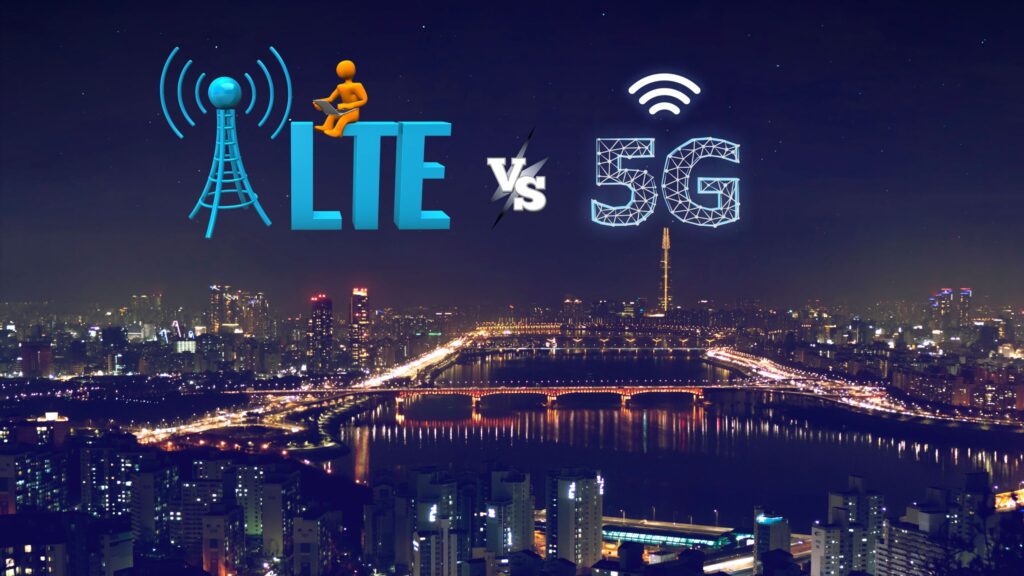LTE (Long-Term Evolution) and 5G (Fifth Generation) are two most prominent mobile technology standards. Understanding the nuances between these two technologies is crucial for comprehending the present landscape and anticipating future developments in wireless communication.
What is LTE?
We’ve all heard of 4G and 5G in cellular network technology. But you may have seen the term “4G LTE” and wondered, what does LTE stand for? The short answer is that LTE stands for “Long Term Evolution” and it is most commonly used in connection with 4G, the fourth-generation global wireless communication standard that was first defined in 2008.
As 5G is rolling out around the world, there are many questions about network technology and terminology. For example, is 4G going away? Is 4G LTE going away? And if so, when?
In this blog, we’ll briefly review the background of LTE. We will look at its role in cellular communications, its relationship to 5G — the next generation of cellular network technology — and how long 4G LTE and 5G will co-exist.
What Is LTE Long-Term Evolution?
LTE, or Long-Term Evolution, is a standard for wireless broadband communication that evolved on 4G networks. While not technically the same as 4G, LTE delivers faster data speeds and lower latency, making it a key step toward true 4G performance.
For most users, LTE is first noticed on their phone screens, indicating connection to a carrier’s 4G LTE network. In commercial and industrial settings—such as transportation, government, and healthcare—LTE supports robust, long-term connectivity.
Introduced in 2008, LTE offered higher data rates, better efficiency, and lower latency. It continues to evolve, improving battery life, speed, and cost efficiency. As 2G and 3G networks sunset, LTE remains a strong, future-proof option for device deployments. Businesses using LTE today can rely on its long-term viability, especially as migration to 4G and 5G becomes essential.
LTE technology has delivered multiple benefits worldwide:
- LTE connectivity is almost universally available around the world for both consumer and commercial/industrial applications.
- LTE provides long-term network continuity as older networks such as 2G and 3G sunset.
- In regions where 5G will not be available for some time, 4G LTE, 4G LTE Advanced, and 4G LTE Advanced Pro technology will support migration needs from 2G/3G for years to come.
- LTE offers higher speeds as well as significant benefits for low power applications and simpler, low-cost devices — providing a single technology foundation for a wide variety of use cases.
How Does LTE Work?
LTE improves upon the functionality and performance of older networks. This brief LTE description from Keven Sookecheff provides an excellent LTE overview to help understand how LTE works:
LTE is a redesign of the 3G standard to satisfy the demand for low latency data transmission. The redesign includes:
- An IP address based core network
- Simplified network architecture
- New radio interface
- New modulation method
- Multiple input, multiple output radios (MIMO) for all devices
Here are a few important facts to know about how LTE works at a high level:
- LTE offers lower latency and increased throughput throughout the network, dramatically improving upon 3G network performance.
- LTE operates on a separate spectrum from 3G networks and requires new hardware.
- LTE provides fast data download speeds of several 100th megabits per second (Mbps), compared to several 10th Mbps for 3G, meaning that LTE is 5-10 times faster than 3G.
- LTE can support data, voice (VoLTE), instant messaging and video on smartphones and tablets over a single interface. With 3G, this was done over different systems, and on some networks voice and data was mutually exclusive.
In the 4G LTE, User Equipment (UE) like smartphones or cellular devices, connects over the LTE Radio Access Network (E-UTRAN) to the Evolved Packet Core (EPC) and then further to External Networks, like the Internet. The Evolved NodeB (eNodeB) separates the user data traffic (user plane) from the network’s management data traffic (control plane) and feeds both separately into the EPC.
What is 5G?
5G (Fifth Generation Standard)
5G, the fifth generation of wireless technology, is not merely an incremental upgrade but also a transformative leap that aims to revolutionize how we interact with technology. It represents the next frontier in mobile communication, promising unprecedented performance, connectivity, and innovation. With peak data rates, 5G will enable us to harness the potential of the Internet of Things (IoT), artificial intelligence, and augmented reality.
5G is the 5th generation mobile network. It is a new global wireless standard after 1G, 2G, 3G, and 4G networks. 5G enables a new kind of network that is designed to connect virtually everyone and everything together including machines, objects, and devices.
5G wireless technology is meant to deliver higher multi-Gbps peak data speeds, ultra low latency, more reliability, massive network capacity, increased availability, and a more uniform user experience to more users. Higher performance and improved efficiency empower new user experiences and connects new industries.
How and When will 5G Affect the Global Economy?
5G is driving global growth.
- $13.1 Trillion dollars of global economic output
- 22.8 Million new jobs created
- $265B global 5G CAPEX and R&D annually over the next 15 years
Through a landmark 5G Economy study, we found that 5G’s full economic effect will likely be realized across the globe by 2035—supporting a wide range of industries and potentially enabling up to $13.1 trillion worth of goods and services.
This impact is much greater than previous network generations. The development requirements of the new 5G network are also expanding beyond the traditional mobile networking players to industries such as the automotive industry.
Study also revealed that the 5G value chain (including OEMs, operators, content creators, app developers, and consumers) could alone support up to 22.8 million jobs, or more than one job for every person in Beijing, China. And there are many emerging and new applications that will still be defined in the future. Only time will tell what the full “5G effect” on the economy is going to be.
LTE vs 4G
| Aspect | LTE (Long-Term Evolution) | 4G (Fourth Generation) |
|---|---|---|
| Speed | Provides download speeds of up to 100 Mbps | Provides download speeds of up to 1 Gbps |
| Technology Type | A type of 4G technology, but not fully 4G | Full 4G technology, offering advanced performance |
| Latency | Lower latency than 3G, around 30-50 ms | Typically offers lower latency than LTE, around 10-20 ms |
| Network Coverage | Covers most urban areas and some rural areas | Covers wider geographic areas, generally more widespread |
| Data Transfer | Focused on improving mobile broadband speeds | Offers significant improvements in broadband capabilities |
| Applications | Ideal for video streaming, VoIP, and mobile internet browsing | Designed for high-speed internet, HD video calls, and interactive applications |
LTE vs 5G
5G is faster and has more capacity than LTE, with lower latency. 5G is built on a new radio technology that uses high-frequency radio waves.
| Aspect | LTE (4G) | 5G (Fifth Generation) |
|---|---|---|
| Speed | Up to 100 Mbps, suitable for streaming and browsing | Up to 1 Gbps, enabling HD video streaming, VR, and faster downloads |
| Coverage | Extensive, available in most populated areas globally | Limited availability, only in specific regions or cities |
| Capacity | Supports up to 1000 devices per cell tower | Can support significantly more devices per cell, enhancing network performance |
| Technology Type | Incremental improvement over previous generations | Revolutionary leap, with capabilities for IoT, AI, and augmented reality |
| Applications | Video streaming, online gaming, HD voice calls | IoT, smart cities, autonomous vehicles, VR/AR experiences |
FAQs
1. What is LTE?
LTE (Long Term Evolution) is a wireless communication standard used for high-speed data transfer in mobile networks. It is considered a 4G technology but offers faster speeds than previous generations like 3G.
2. What is the difference between LTE and 4G?
LTE is often marketed as 4G, but technically, it is a subset of 4G. 4G provides faster speeds and lower latency than LTE, but LTE is still considered a significant step up from 3G networks.
3. What is 4G?
4G (Fourth Generation) is the fourth generation of mobile network technology. It provides significantly faster speeds and better performance compared to 3G, enabling advanced features such as HD video streaming and faster downloads.
4. How fast is LTE compared to 3G?
LTE offers speeds up to 100 Mbps for downloading and 50 Mbps for uploading, which is much faster than 3G’s peak speeds of 42 Mbps for downloading and 21 Mbps for uploading.
5. What is 5G?
5G (Fifth Generation) is the latest generation of mobile networks, providing faster speeds, higher capacity, and lower latency than both 4G and LTE. It is designed to support more connected devices and enable new technologies like IoT and autonomous vehicles.
6. How fast is 5G?
5G can offer download speeds of up to 10 Gbps, which is about 100 times faster than 4G networks, enabling instant downloads, ultra-low latency, and real-time data processing.
7. How does 5G work?
5G operates on a new set of frequency bands, including millimeter waves, which allow it to deliver faster speeds and greater bandwidth. It uses a combination of small cell networks and advanced technologies like MIMO (multiple input, multiple output) to achieve higher speeds and lower latency.
8. Do I need a new phone for 5G?
Yes, to use 5G, you need a device that is compatible with 5G networks. Most recent flagship smartphones support 5G, but older models may not.
9. What is the difference between 4G and 5G?
5G offers faster speeds, lower latency, and greater capacity than 4G. 4G can handle speeds up to 1 Gbps, while 5G can exceed 10 Gbps, making 5G suitable for emerging technologies like augmented reality, virtual reality, and autonomous vehicles.
10. Will 5G replace 4G and LTE?
5G is not expected to replace 4G and LTE immediately. While 5G will become the primary network for high-speed internet, 4G and LTE will continue to be in use for several years, especially in areas where 5G infrastructure is not yet available.
11. Can I use 4G and LTE together?
Yes, in many cases, LTE operates as a part of the 4G network. Devices on the 4G network may switch between LTE and other 4G technologies depending on the network’s availability and conditions.
12. What are the benefits of 5G over 4G?
5G offers faster speeds, lower latency, and more reliable connections. This leads to better experiences with streaming, gaming, and real-time applications, as well as improved support for smart cities, healthcare, and autonomous systems.
13. Will 5G work with existing 4G LTE networks?
Yes, 5G networks are designed to work alongside 4G LTE, using a hybrid system that allows devices to seamlessly switch between 4G and 5G depending on coverage and network conditions.
14. How does 5G impact IoT (Internet of Things)?
5G will enable the widespread growth of IoT by offering faster speeds, lower latency, and a larger capacity for connected devices. It will improve real-time data processing, enabling innovations like smart cities and connected autonomous vehicles.
15. Will 5G be available everywhere?
5G networks are being rolled out globally, but availability varies by region. It is expected that 5G coverage will expand significantly over the next few years, particularly in urban areas and regions with advanced infrastructure.
16. What are the health concerns about 5G?
There have been concerns about the potential health effects of 5G due to the use of higher-frequency waves. However, most scientific studies and health organizations, including the WHO, have found that the radiation levels from 5G are well below harmful thresholds.
17. How will 5G impact the speed of mobile apps?
5G will significantly improve the speed and responsiveness of mobile apps. Apps that rely on real-time data, such as gaming, video streaming, and augmented reality, will benefit from reduced latency and faster data transfer speeds.
18. Can 4G LTE still provide good internet speeds?
Yes, 4G LTE still provides fast and reliable internet speeds for most applications, including browsing, video streaming, and gaming. While 5G is faster, 4G LTE remains suitable for everyday use.
19. What industries will benefit the most from 5G?
Industries such as healthcare, manufacturing, automotive, entertainment, and logistics will see significant benefits from 5G, as it will enable innovations like remote surgery, autonomous vehicles, smart factories, and high-quality live streaming.
20. Is 5G compatible with older networks?
Yes, 5G is designed to coexist with older networks, including 4G, 3G, and 2G, ensuring that devices can continue to function in areas where 5G is not yet available.




